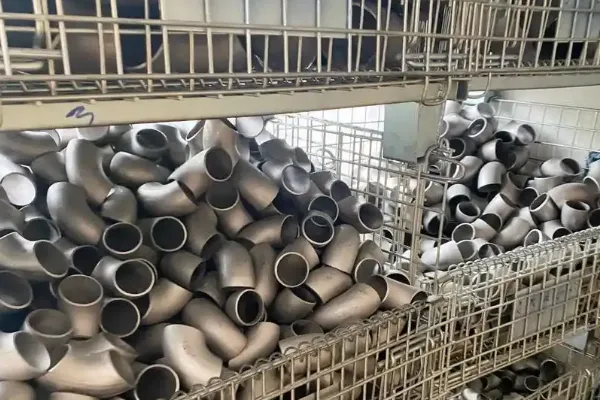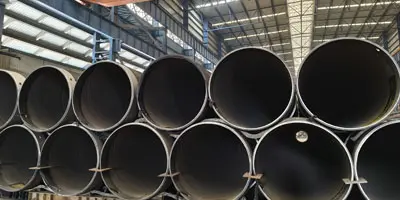Stainless steel pipe fittings play a vital role in modern fluid transportation systems. Whether in residential water supply systems, industrial piping networks, or municipal construction, their durability, corrosion resistance, and aesthetic appeal make them a preferred choice. Among the many types of stainless steel pipe fittings, equal-diameter joints and 90° elbows are the most commonly used and represent a wide application range in actual piping installations. This article introduces the main production processes of stainless steel pipe fittings, taking equal-diameter joints and 90° equal-diameter elbows as examples, while explaining relevant standards implemented in China.
Production Process of 90° Equal-Diameter Stainless Steel Elbows
90° elbows are widely used for changing the direction of fluid flow in piping systems. Their production process involves bending and forming operations that differ slightly from straight couplings:
1.Equidistant Cutting:
Similar to straight joints, elbow production begins with cutting stainless steel pipes into uniform segments according to the required radius and wall thickness.
2.Pipe Bending: Manual and Automatic:
There are two main types of machines used for pipe bending:
Manual Pipe Bending Machine:
Operators manually place the pipe into the bending mold, and then use hydraulic pressure or mechanical force to achieve the 90° curvature.
Automatic Pipe Bending Machine:
In modern factories, automation has greatly improved efficiency and consistency. Cut pipe sections are placed into feeding grooves, and robotic arms automatically pick them up, place them into the mold, and complete the bending process with high repeatability.
3.Water Expansion Forming:
After bending, the elbows are processed through the same high-pressure water expansion forming machine used for straight joints. This step helps to finalize the shape, especially to ensure the elbow’s internal diameter remains consistent throughout the bend.
4.Final Finishing and Inspection:
Elbows undergo further inspection for roundness, wall thickness uniformity, and surface integrity. Depending on the application, additional treatments such as annealing, pickling, or passivation may be applied to enhance corrosion resistance.

Implementation Standards for Stainless Steel Pipe Fittings
In China, stainless steel pipe fittings are manufactured in accordance with several key standards to ensure quality and compatibility with piping systems. Among these, the most relevant are:
National Standard I Series :
This is the most widely used standard across China and covers the general specifications for stainless steel pipe fittings.
National Standard II Series and European Standards:
These are used less frequently and mainly in specialized or imported equipment systems. Some projects that require international compatibility may specify European standards.
GBT 19228.1-2011 Standard:
This is the most authoritative standard for thin-walled stainless steel pipe fittings in China. Issued in 2011 and implemented in 2012, this standard outlines the nominal pressure and dimensional tolerances for fittings.
For fittings below DN100, the nominal pressure must not exceed PN16, ensuring safety under standard working conditions.
This standardization ensures interchangeability and safety, especially in systems such as potable water supply, fire protection systems, HVAC installations, and more.
Commonly used materials for stainless steel pipe fittings
1. 304 stainless steel pipe fittings
304 stainless steel pipe fittings have become popular. Although 304 and 304L stainless steel are slightly more expensive than 201 stainless steel, they are better than 201 stainless steel in terms of corrosion resistance, service life, temperature resistance, etc. Therefore, in order to better meet the demand for high-quality stainless steel pipe fittings, many manufacturers use 304 materials to make stainless steel pipe fittings.
2. 316L stainless steel pipe fittings
316L stainless steel pipe fittings have gradually become popular. If your stainless steel pipe fittings are used on the coast, they may be corroded by the sea level and blown by the cool sea breeze. The service life of stainless steel pipe fittings made of conventional 201/304 stainless steel will be affected, so it is necessary to use 316L stainless steel pipe fittings with better performance parameters.
Common Types of Stainless Steel Pipe Fittings
Before diving into the production process, it's important to understand the diversity of stainless steel pipe fittings. These include:
Equal-diameter joints
Reducing joints
Adjustable joints
90° elbows A/B types
External thread tee adapters
Reducing tees
Internal thread
tee adapters
45° elbows A/B types
Equal-diameter tees and crosses
Internal and external thread joints
Dynamic curtain joints
Pipe caps
Pipe bridges
Each type of fitting serves a specific function in a piping system, such as directional changes, diameter transitions, or pipe terminations.
Conclusion
Stainless steel pipe fittings like equal-diameter joints and 90°
elbows are essential components in modern piping systems. Their production involves a sophisticated combination of precise cutting, hydraulic forming, and rigorous quality control. As domestic manufacturing continues to evolve, the adoption of national standards like GBT 19228.1-2011 ensures consistent quality and reliability across applications. Whether used in municipal water systems, industrial plants, or high-end construction projects, these fittings continue to demonstrate their value in durability, performance, and efficiency.






 English
English Español
Español بالعربية
بالعربية











 Phone :
Phone :  Whatsapp :
Whatsapp :  Email :
Email : 


